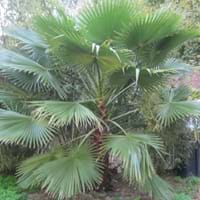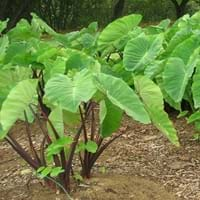Life Span
Perennial
Annual
Type
Palm or Cycad
Tender Perennial
Origin
United States, Southeastern United States
Southeastern Asia
Types
Not Available
Eddoe taro, Dasheen taro
Number of Varieties
Not Available
Habitat
Coastal sand dunes, Dry areas, moist forests, Wet lands
agricultural areas, Hillside, Warm and moist climatic conditions
USDA Hardiness Zone
8-12
10-11
Sunset Zone
H1, H2, 7, 8, 9, 10, 11, 12, 14, 15, 16, 17, 18, 20, 21, 22, 23, 24
H1, H2, 22, 23, 24
Habit
Clump-Forming
Clump-Forming
Flower Color
White
White, Green
Flower Color Modifier
Bicolor
Not Available
Leaf Color in Spring
Light Green, Blue Green, Gray Green
Dark Green, Ivory
Leaf Color in Summer
Green, Blue Green, Gray Green, Silver
Dark Green, Ivory
Leaf Color in Fall
Blue Green, Gray Green
Dark Green, Ivory
Leaf Color in Winter
Blue Green, Olive, Gray Green
Dark Green, Ivory
Leaf Shape
Palmate
V-Shaped
Plant Season
Spring, Summer, Fall, Winter
Spring, Summer, Fall, Winter
Sunlight
Full Sun, Partial Sun, Partial shade
Partial shade, Full Shade
Type of Soil
Clay, Loam, Sand
Loam, Sand
The pH of Soil
Acidic, Neutral, Alkaline
Acidic, Neutral
Soil Drainage
Well drained
Well drained
Bloom Time
Spring, Late Spring
Indeterminate
Tolerances
Wet Site, Pollution, Salt, Soil Compaction
Heat Tolerance, Humidity, Salt and Soil Compaction, Shallow soil
Where to Plant?
Container, Ground
Container
How to Plant?
Seedlings
From Rhizomes
Plant Maintenance
Medium
Medium
Watering Requirements
Drought Tolerant, occasional watering once established
Needs 2-3 times watering per week, Needs a lot of water initially
In Summer
Lots of watering
Lots of watering
In Spring
Moderate
Moderate
In Winter
Average Water
Average Water
Soil pH
Acidic, Neutral, Alkaline
Acidic, Neutral
Soil Type
Clay, Loam, Sand
Loam, Sand
Soil Drainage Capacity
Well drained
Well drained
Sun Exposure
Full Sun, Partial Sun, Partial shade
Partial shade, Full Shade
Pruning
Remove damaged leaves, Remove dead branches, Remove dead leaves
No pruning needed
Fertilizers
All-Purpose Liquid Fertilizer
All-Purpose Liquid Fertilizer, Less fertilizing
Pests and Diseases
Birds
Aphids, Rats, Snails
Plant Tolerance
Drought
Heat Tolerance, Salt and Soil Compaction, Shade areas
Flowers
Insignificant
Insignificant
Flower Petal Number
Single
Not Available
Foliage Texture
Coarse
Bold
Foliage Sheen
Matte
Glossy
Attracts
Birds
Aphids, Bugs, Not Available, Snails
Allergy
gas, Heartburn, Nausea, Stomach pain, Vomiting
Swelling in mouth, Throat itching
Aesthetic Uses
Unknown
Showy Purposes
Beauty Benefits
Not Available
Poison Ivy, Skin cleanser, Weightloss
Environmental Uses
Air purification
No fertilizer, pesticides, or herbicides needed, Prevent weeds
Medicinal Uses
chest congestion, Cough, Digestion problems, Inflammation, Sedative, Thyroid problems, Urinary problems
Aging, Laxative, Weight loss
Part of Plant Used
Fruits
Leaf Stalks, Leaves
Other Uses
Paper pulp, Used in herbal medicines
Used As Food, Used as Ornamental plant
Used As Indoor Plant
No
No
Used As Outdoor Plant
Yes
Yes
Garden Design
Container, Feature Plant, Foundation, Mixed Border, Rock Garden / Wall, Tropical
Container, Feature Plant, Groundcover, Houseplant, Mixed Border, Tropical
Botanical Name
SERENOA repens
ALOCASIA micholitziana
Common Name
Saw Palmetto
Elephant Ear, Taro
In German
Sägepalme
Colocasia (Pflanzengattung)
In French
Serenoa repens
Colocasia
In Spanish
Serenoa repens
Colocasia
In Greek
Serenoa
Colocasia
In Portuguese
Serenoa repens
Colocasia
In Polish
Serenoa
Kolokazja
In Latin
Serenoa
Colocasia
Phylum
Magnoliophyta
Magnoliophyta
Class
Liliopsida
Liliopsida
Genus
Serenoa Hook. f.
Alocasia
Clade
Angiosperms, Commelinids, Monocots
Angiosperms, Monocots
Tribe
Trifolieae
Colocasiodeae
Subfamily
Coryphoideae
Aroideae
Season and Care of Saw Palmetto and Taro
Season and care of Saw Palmetto and Taro is important to know. While considering everything about Saw Palmetto and Taro Care, growing season is an essential factor. Saw Palmetto season is Spring, Summer, Fall and Winter and Taro season is Spring, Summer, Fall and Winter. The type of soil for Saw Palmetto is Clay, Loam, Sand and for Taro is Loam, Sand while the PH of soil for Saw Palmetto is Acidic, Neutral, Alkaline and for Taro is Acidic, Neutral.
Saw Palmetto and Taro Physical Information
Saw Palmetto and Taro physical information is very important for comparison. Saw Palmetto height is 210.00 cm and width 300.00 cm whereas Taro height is 30.00 cm and width 30.00 cm. The color specification of Saw Palmetto and Taro are as follows:
Saw Palmetto flower color: White
Saw Palmetto leaf color: Light Green, Blue Green and Gray Green
Taro flower color: White and Green
- Taro leaf color: Dark Green and Ivory
Care of Saw Palmetto and Taro
Care of Saw Palmetto and Taro include pruning, fertilizers, watering etc. Saw Palmetto pruning is done Remove damaged leaves, Remove dead branches and Remove dead leaves and Taro pruning is done No pruning needed. In summer Saw Palmetto needs Lots of watering and in winter, it needs Average Water. Whereas, in summer Taro needs Lots of watering and in winter, it needs Average Water.





